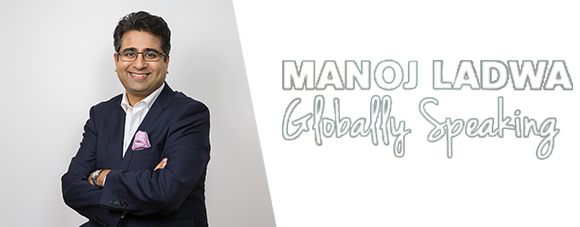India’s Cabinet reshuffle signals the BJP stepping up the tempo on reforms and policy delivery ahead of the 2019 general elections, writes India Inc. Founder & CEO Manoj Ladwa.
Indian Prime Minister Narendra Modi’s uncanny ability to spring surprises and stay one step ahead of the Opposition was on full display when he reshuffled his Council of Ministers on September 3, 2017. He promoted four top performing Ministers of State to full Cabinet rank and inducted nine new members as Ministers of State.
A few minutes after the swearing in, commentators on almost every TV channel and online news portals were asking: “So what?” The early consensus was that Modi’s last Cabinet reshuffle/expansion was mere tinkering and lacked a bigger picture.
A few moments later, the portfolios were announced. That suddenly changed the narrative completely and forced even sworn critics such as former Jammu & Kashmir Chief Minister Omar Abdullah to congratulate the Prime Minister.
What had changed in a matter of an hour?
The Prime Minister had lived up to his reputation of being focused on performance and delivery and had appointed four former bureaucrats – India’s former representative to the UN Hardeep Puri, former Home Secretary R.K. Singh, former Police Commissioner of Mumbai S.P. Singh and former DDA Commissioner K. Alphons (who earned the sobriquet of Demolition Man for his successful drive to demolish more than 15,000 illegal buildings in Delhi) – in important people-facing ministries.
Then, he rewarded performance by promoting four of his top performing Ministers of State – Power, Renewable Energy and Coal Minister Piyush Goyal, Commerce Minister Nirmala Sitharaman, Minority Affairs Minister Mukhtar Abbas Naqvi and Petroleum, Oil and Natural Gas Minister Dharmendra Pradhan – to full Cabinet rank.
But the biggest talking point was the appointment of Minister State for Commerce and Industry Nirmala Sitharaman to the position of Minister of Defence. In India, the ministries of Home, Finance, Defence and Foreign Affairs are called the “Big Four” as the ministers are ex-officio members of the all-important Cabinet Sub-Committee called the Cabinet Committee on Security (CCS).
Sitharaman is the first woman Defence Minister of India. Earlier, Prime Minister Indira Gandhi had twice held concurrent charge of defence when the then defence ministers had been moved to other departments.
Thus, for the first time in India’s history, there are two women –Sitharaman and Foreign Minister Sushma Swaraj – on the CCS.
Sitharaman who took over as Defence Minister from Arun Jaitley, who was holding additional charge of the portfolio in addition to his regular day job as Finance Miniser, has said her priorities would be military preparedness, ‘Make in India’ and welfare of soldiers and their families.
“My priority will definitely be the armed forces preparedness. It is important that the Indian armed forces receive the attention in terms of giving them every endowment and equipment necessary for them to perform their duty with the best of equipment available,” she said in a message after assuming charge.
As Commerce Minister, Sitharaman had piloted the Make in India initiative under the guidance of the Prime Minister. Now, as Minister of Defence, she will have to oversee the initiative to build a domestic defence industrial base almost from scratch.
On her plate are proposals from US defence contractor Lockheed Martin and Swedish plane maker SAAB to make the F-16 and Gripen fighters in India. Then, there are plans to build dozens of submarines, armoured vehicles, guns and missiles in the private sector with collaboration and transfer of technology from foreign vendors.
Jaitley has already drawn up the blueprint for this, but she will have to now write the fine print of this policy and roll it out. It’s a huge challenge and I wish her the very best in her endeavours.
 Piyush Goyal, who is credited with turning India’s moribund power sector around, was elevated to full Cabinet rank and given charge of the Railways portfolio.
Piyush Goyal, who is credited with turning India’s moribund power sector around, was elevated to full Cabinet rank and given charge of the Railways portfolio.
This department, which had a budget that was placed before Parliament separately from the General Budget till this year, has been badly neglected for more than 70 years. Previous governments had used the Railways as a milch cow. Most previous Railway Ministers had used it to benefit their own political constituencies, keeping passenger fares artificially low, announcing new trains in uneconomic sectors and neglecting modernisation and safety.
As a result, the Indian Railways, the world’s second largest, is plagued by inefficiencies, a bloated work force and an abysmal safety record. Suresh Prabhu, Goyal’s predecessor had begun the work of restoring the Railways to financial and operational health, allocating about $20 billion for modernising this gargantuan organisation and improving safety.
By most metrics, he did a good job. The number of accidents came down, track modernisation and electrification were taken up on a war footing and the number of railway accidents actually came down substantially during his tenure.
Unfortunately, three accidents in the last month of his tenure led to dozens of tragic deaths, prompting the very conscientious Prabhu to tender his resignation to the Prime Minister, who reportedly asked him “to wait”.
Goyal now has his work cut out. He will have to build on the platform laid by Prabhu and complete the modernisation programme already underway. Given his success in the equally bureaucratic and till recently moribund Power Ministry, there is reason for optimism that the Railways’ journey to good health will continue unhindered.
The media declared that Prabhu was on his way out of the ministry. But Modi, a sharp judge of performance and talent, wasn’t done with him. He simply transferred him to the Commerce and Industry Ministry vacated by Sitharaman.
Here, his biggest priorities will be to ensure a turnaround in India’s export performance. But given the winds of protection blowing in the US and the EU, India’s two biggest export markets, this will not be an easy task.
Then, he will also have to ensure that Make in India, one of the government’s flagship initiatives, is carried through to its logical conclusion.
In many ways, these two tasks are related. In order to lift exports, Indian industry will have to produce more, at lower prices and at quality levels acceptable to global buyers.
But private investments – key to the success of Make in India – have been stubbornly stagnant for a number of reasons, the most important ones being the inability of banks to lend and the lingering effects of archaic rules and a lethargic bureaucracy, resulting in a poor ranking in the World Bank’s Ease of Doing Business Index.
The first bottleneck is being addressed jointly by the Reserve Bank of India and the Ministry of Finance in the form of speeded up proceedings under the new Bankruptcy Code.
The second bottleneck – on improving India’s ranking on ease of doing business – is now in Prabhu’s court. The Department of Industrial Policy and Promotion under the Ministry of Commerce has taken several steps to make it easier to do business in India. This has resulted in an improvement in India’s ranking on the index from 142 to 130, the biggest annual improvement by any country.
Prabhu will have to ensure that the momentum is maintained so as to be able to achieve Modi’s vision of breaking into the top 50 in the World Bank’s Ease of Doing Business Index within a reasonable period of time.
The Prime Minister has appointed former Home Secretary R.K. Singh as the new Minister of State (Independent Charge) of the Ministries of Power and Renewable Energy, the ministries headed by Goyal. A first-term Member of Parliament, Singh has big shoes to fill. His induction into the ministry has surprised many but in my opinion, it goes to show that the Prime Minister and BJP President Amit Shah have chosen merit over politics keeping in mind the looming elections just 18 months away.
Singh has a reputation as an incorruptible, efficient and well regarded officer with a proven track record of delivering on difficult assignments during his 34 years of bureaucratic service. He retired in 2013, so, all the officials in his new ministry are his service juniors. He also has the advantage of being an insider, who knows how to get work done in New Delhi’s notoriously labyrinthine and Byzantine power circles.
Singh has said he will carry on and complete the work started by his predecessor Piyush Goyal. When asked about his priorities as Power and RE Minister, he said he will comment on his new charge after a few days (ie, after he is briefed by his predecessor and the officials in his two departments).
Skill India, the ambitious programme to reskill the Indian workforce is probably one flagship initiative that hasn’t yet borne fruit. It has been placed under the stewardship of Petroleum Minister Dharmendra Pradhan, who earned his spurs by making a huge success of the Prime Minister’s pet scheme to distribute free cooking gas cylinders to families below the poverty line.
And Nitin Gadkari, who epitomises the Modi government’s can-do-will-do credo, has been given additional charge of River Development and Ganga Rejuvenation. He got off the blocks quickly by announcing his intention of creating a national water grid – on the lines of the power grid – to evacuate water from surplus regions to supply the same to regions facing a deficit in order to tackle the perennial problem of simultaneous floods and droughts in different regions of this vast country.
The next General Election is due in April-May 2019. The ruling BJP also faces several important state elections – in Himachal Pradesh, Gujarat, Madhya Pradesh, Rajasthan and Chhattisgarh – between end-2017 and end-2018.
The reshuffle seems to suggest the Prime Minister is keen on handing over the implementation of key election promises (which are crucial for his re-election) to professionals and proven performers.
The latest reshuffle also seems to suggest that the usual considerations in Indian politics – of distributing portfolios according to caste, region and political heft – have played a lesser role this time.
The overall composition of the refreshed Council of Ministers also strongly suggests that Modi’s reforms agenda will continue and even gather pace.







